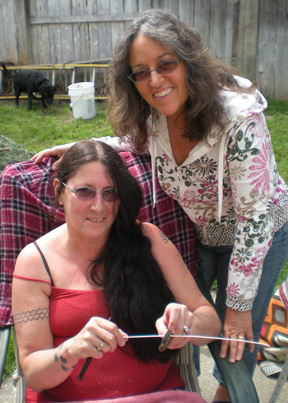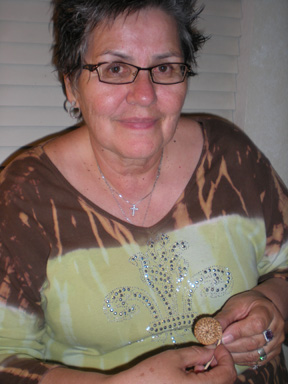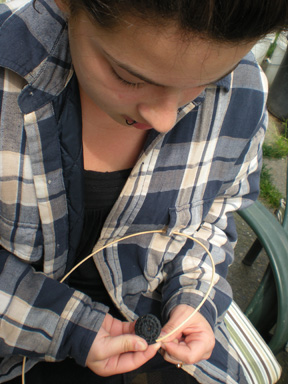On March 19 & 20, 2010 I visited Carol’s house for another weaving lesson. The weather was beautiful so this time we were happy to be able to work outside and soak up some much appreciated sun. On Friday, our Mutsun Ohlone friend Jakki was able to join us again.
I wanted us to think about our goals for this session, and we identified the following:
CAROL
1. To get my guidance on cleaning her sedge
2. To get my guidance on her placement of stitches
3. To teach her how to scrape & size her willow sticks
4. To transition the foundation of her coil start from a sedge bundle to 3 willow sticks
JAKKI
1. To learn to trim & clean sedge in preparation for weaving
2. To learn to stitch with sedge on a commercial round reed foundation
My goal for Anissa & Arianna was to transition them to coiling with finer material, with the idea of teaching them the skills necessary for weaving with our traditional plant materials.
After working together these two days, Carol learned that she hadn’t been trimming down her sedge enough, so her stitches weren’t lying down evenly. We also worked on making sure that her stitches are evenly spaced and that she adds stitches when necessary so that her stitches don’t slant. We were both really happy with this breakthrough! It’s going to make a big difference in the quality of her weaving.

On Saturday, we also spent part of the day working on scraping down willow sticks. Because willow shoots are tapered, it’s necessary to scrape down the broader end so that the willow rods will all have a relatively uniform diameter. I showed Carol how to use the hole in a small abalone shell as a sizing gauge. She scraped and checked the diameter over and over again, working her way down the willow shoot until even the broad end could slip through the designated sizing hole.
Before finishing, I helped her insert 3 very small willow sticks as the foundation material. Because a willow stick can’t bend tight enough to begin the very center of a coiled basket, we use a small bundle of flexible sedge material in the beginning. But the time had come to transition to willow. Later, Carol will transition to larger willow foundation sticks.
Jakki spent her time learning to trim and clean sedge material to get it ready for weaving. When first learning, it’s easy to ruin the material, and this happened a few times, but it’s all part of the learning process. We all have to start from the beginning, and she did a great job. Besides trimming each strand with a knife to even out its thickness, Jakki learned to pull the strands through a small hole drilled in a piece of abalone shell to help remove the loose fibers from the surface. A lot of work and patience is required even before the weaving ever begins!
Next it was time to learn to stitch with her newly-trimmed and cleaned sedge on a commercial round “reed” foundation. I wanted Jakki to begin with this commercial foundation material because it will spare her the challenge of constantly splicing in willow sticks. She’ll have enough to manage in the beginning, just learning how to stitch properly. Later, she’ll have mastered that and can then concentrate on the additional challenge of preparing and adding willow sticks.

Because beginning a coil basket is difficult, I made a small coiled basket start at home and brought it for Jakki to begin her weaving. She was very patient and didn’t seem to mind taking out stitches from time to time in order to get it right.
On Saturday, Anissa and Arianna dedicated the day to taking their new weaving skills to the next level. As you will remember, last month they learned to weave with pine needles and raffia. This time we graduated to smaller material, both for the foundation and the stitching material. Again, I was thrilled at how quickly both of them caught on. They stitched with a needle and black twine over a commercial round wood “reed.” All the skills they’re learning are leading them to weaving with our traditional native plant materials.


Next week Carol and the girls are coming to Monterey and we’ll go out to dig sedge roots at Fort Ord BLM (Bureau of Land Management) land. I’ll tell you all about it and share photos of this stunningly beautiful place in my next entry!
